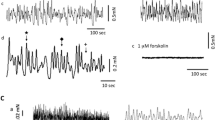Summary
The effect of varying the potassium ion concentration on autonomic neuro-muscular transmission was studied in the vas deferens of the mouse. The smooth muscle cells had resting membrane potentials in normal solution of about 75 mV. The relationship between the membrane potential and the external potassium concentration was close to that predicted by the Nernst equation for external potassium concentrations above 20 mM. The relationship followed the trend predicted by the Goldman equation. The time of decay of the excitatory junction potential (EJP) in response to nervous stimulation decreased to one quarter when the potassium concentration was increased from 0 to 5 times that in normal solution. The transmission delay at the autonomic junction did not change, and the rise time of the EJP decreased only slightly, with increased external potassium concentration. The maximal amplitude of the EJP decreased with increased external potassium. Miniature EJPs (MEJPs) occurred spontaneously and had the same time course in each concentration of external potassium. In potassium-free solution spontaneous potentials, which were similar in time course to EJPs in the same solution, were also observed. It is concluded that the repolarizing phase of the EJP in normal solution is probably determined by the electrical properties of the smooth muscle.
Similar content being viewed by others
References
Adrian, R. H., Freygang, W. H.: The potassium and chloride conductance of frog muscle membrane. J. Physiol. (Lond.)163, 61–103 (1962).
Bell, C.: Effects of cocaine and of monoamine oxidase and catechol-O-methyl transferase inhibitors on transmission to the guinea-pig vas deferens. Brit. J. Pharmacol.31, 276–289 (1967).
Bennett, M. R.: Transmission from excitatory nerves to the smooth muscle cells of rat seminal vesicles. Nature (Lond.)215, 60–61 (1967).
—, Merrillees, N. C. R.: An analysis of the transmission of excitation from autonomic nerves to smooth muscle. J. Physiol. (Lond.)185, 520–535 (1966).
Bogdanski, D. F., Brodie, B. B.: The effects of inorganic ions on the storage and uptake of H3-norepinephrine by rat heart slices. J. Pharmacol. exp. Ther.165, 181–189 (1969).
Bülbring, E., Kuriyama, H.: Effects of changes in ionic environment on the action of acetylcholine and adrenaline on the smooth muscle cells of guinea-pig taenia coli. J. Physiol. (Lond.)166, 59–74 (1963).
Burnstock, G.: The effects of acetylcholine on membrane potential and excitability in the taenia coli of the guinea-pig. J. Physiol. (Lond.)143, 165–182 (1958).
—, Holman, M. E.: Spontaneous potentials at sympathetic nerve endings in smooth muscle. J. Physiol. (Lond.)160, 446–460 (1962).
——: Junction potentials at adrenergic synapses. Pharmacol. Rev.18, 481–493 (1966).
Del Castillo, J., Katz, B.: On the localization of acetylcholine receptors. J. Physiol. (Lond.)128, 167–181 (1955).
Eccles, J. C., Katz, B., Kuffler, S. W.: Nature of the end plate potential in curarized muscle. J. Neurophysiol.4, 362–387 (1941).
Ferry, C. B.: The innervation of the vas deferens of the guinea-pig. J. Physiol. (Lond.)192, 463–478 (1967).
— Furness, J. B.: The effect of potassium on the time course of junctional events in smooth muscle. Aust. J. exp. Biol. med. Sci.47, 12 P (1969).
—: The excitatory input to a single smooth muscle cell. Pflügers Arch.314, 1–13 (1970).
—, Burnstock, G.: A comparative study of spike potentials in response to nerve stimulation in the vas deferens of the mouse, rat and guinea-pig. Comp. Biochem. Physiol.31, 337–346 (1969).
Furness, J. B., McLean, J. R., Burnstock, G.: Distribution of adrenergic nerves and changes in neuromuscular transmission in the mouse vas deferens during post-natal development. Develop. Biol. (in the press) (1970).
Goldman, D. E.: Potential, impedance and rectification in membranes. J. gen. Physiol.27, 37–60 (1943).
Grundfest, H.: The properties of mammalian B fibers. Amer. J. Physiol.127, 252–262 (1939).
Hamberger, B., Malmfors, T.: Uptake and release of α-methyl-noradrenaline in vitro after reserpine pretreatment. Acta physiol. scand.70, 412–418 (1967).
Hashimoto, Y., Holman, M. E., McLean, A. J.: Effect of tetrodotoxin on the electrical activity of the smooth muscle of the vas deferens. Nature (Lond.)215, 430–432 (1967).
Hodgkin, A. L.: The effect of potassium on the surface membrane of an isolated axon. J. Physiol. (Lond.)106, 319–340 (1947).
—, Horowitz, P.: The influence of potassium and chloride ions on the membrane potential of single muscle fibres. J. Physiol. (Lond.)148, 127–160 (1959).
—, Katz, B.: The effect of sodium ions on the electrical activity of the giant axon of the squid. J. Physiol. (Lond.)108, 37–77 (1949).
Jenerick, H. P.: Muscle membrane potential, resistance and external potassium chloride. J. cell. comp. Physiol.42, 427–448 (1953).
Katz, B., Miledi, R.: The effect of temperature on the synaptic delay at the neuromuscular junction. J. Physiol. (Lond.)181, 656–670 (1965).
——: Modification of transmitter release by electrical interference with motor nerve endings. Proc. roy. Soc. B167, 1–7 (1967).
Kordas, M.: The effect of membrane polarization on the time course of the end plate current in frog sartorius muscle. J. Physiol. (Lond.)204, 493–502 (1969).
Kuriyama, H.: The effect of temperature on neuromuscular transmission in the vas deferens of the guinea-pig. J. Physiol. (Lond.)170, 561–570 (1964).
Lane, B. P., Rhodin, J. A. G.: Cellular interrelationships and electrical activity in two types of smooth muscle. J. Ultrastruct. Res.10, 470–488 (1964).
Liley, A. W.: The effects of presynaptic polarisation on the spontaneous activity at the mammalian neuromuscular junction. J. Physiol. (Lond.)134, 427–443 (1956).
Nagasawa, J.: The effects of change in ionic milieu and electrical stimulation on the ionic movements in smooth muscle. Tohoku J. exp. Med.82, 103–116 (1964).
Tomita, T.: Current spread in the smooth muscle of the guinea-pig vas deferens. J. Physiol. (Lond.)189, 163–176 (1967).
Yamauchi, A., Burnstock, G.: Post-natal develoment of the innervation in the mouse vas deferens. A fine structural study. J. Anat. (Lond.)104, 17–32 (1969).
Author information
Authors and Affiliations
Rights and permissions
About this article
Cite this article
Furness, J.B. The effect of external potassium ion concentration on autonomic neuro-muscular transmission. Pflugers Arch. 317, 310–326 (1970). https://doi.org/10.1007/BF00586580
Received:
Issue Date:
DOI: https://doi.org/10.1007/BF00586580



